Migraines are commonly known as mild ailments that people frequently experience. Whether it’s from too much stress, loud sounds, or strong smells, migraines are often no cause for serious concern as they can be treated easily.
According to a study, an estimated 10% of the worldwide population is affected by migraines. The ailment often occurs among people between the ages of 20 and 50, with women three times more likely to experience a migraine than men. According to the survey, 5.6% of American men and 17.1% of American women reported having migraine symptoms.
Migraine: A Brief History
Migraine was derived from the Latin word “hemicrania,” with “hemi,” meaning half, and “crania,” translating to the skull. The term was first coined by 1st-century Greek physician Galenus of Pergamon to describe a person’s discomfort across one side of the head during migraine attacks.
The earliest recorded cases of headaches were courtesy of the ancient Egyptians, dating back to 1200 B.C. Later, around the 400 B.C. period, Greek physician, Hippocrates of Kos, otherwise known as Hippocrates II, referred to these sensory disturbances that precede a migraine – such as blurred vision or flashing lights – as aura.
However, migraine discovery was credited to Aretaeus of Cappadocia, describing the unilateral headaches typical of migraines and vomiting symptoms, as well as the timeframes when migraines occurred without any symptoms.
Before the 20th and 21st centuries, migraines were treated more seriously. Back then, society developed unproven and untested cures to remedy a simple headache, sometimes using extreme treatments. Some found that these homemade remedies further exacerbated the symptoms of a migraine.
Fortunately, modern medicine and science have evolved significantly and supplemented society with the proper treatment for migraine.
What is Chronic and Episodic Migraine?
Migraines are often categorized into two basic classes: chronic and episodic.
If you’re experiencing headaches half of the time each month or at least eight days of headaches with migraine features for more than three (3) months, you’re probably suffering from chronic migraine.Headaches of this type start with fewer recurring headache episodes that slowly evolve into more frequent headache patterns.
Episodic migraines are more common than chronic migraines. In comparison, episodic migraines are defined as experiencing headaches with migraine symptoms from zero to 14 days monthly. However, episodic migraine can be categorized into low-frequency episodic migraine (LFEM) and high-frequency episodic migraine (HFEM).
If you experience migraine attacks fewer than 10 times per month, you may have LFEM. On the other hand, if you experience 10 to 14 migraine attacks each month, you probably suffer from HFEM.
While migraines are often viewed as easily curable afflictions, headaches can evolve into a more serious matter. Migraines have different phases, and it’s in your best interest to be knowledgeable about them. Having such awareness can also help someone you know who as they experience unusually severe headaches.
Let this infographic serve as your guide on everything related to the condition, such as the nature of migraine, the causes of migraine, and migraine with and without aura.












